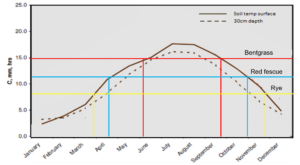When to plant grass seed in the UK?
Introduction
When to plant lawn seed in the UK is one of the most common questions we get from customers. Establishing a healthy lawn from seed is all down to giving it the best start. But to give it the best start it is vital to sow it at the right time of year. In this article we will look at soil temperatures and the effect they have.
Different require different temperatures
In the UK we only use a relatively small set of grass species. Perennial ryegrass, red fescues and bents account for over 90% of grass seed used in the UK for lawns. But these three species have different requirements when it comes to germination temperatures. This in turn effects when is is best to sow them. Below are the temperatures at which you would expect ‘good’ germination.
Perennial ryegrass = 7°C (7-14 days)
Red fescues = 11°C (11-21 days)
Bent = 15°C (11-21 days)
Germination will occur below these temperatures. But it is likely to take longer due to the biochemical processes of germination slowing down.
Soil temperatures in the UK
It is obvious to say that soil temperatures increase as we enter the mid – spring and summer and decline into autumn and winter. However the ground is slow to warm and slow to cool down. This means that in the spring the air temperatures can be good, but soil temperatures can lag behind for a while. For this reason spring months can be challenging, especially if there are dry spells as we head into the summer. With our current climate finding perfect conditions can be hard, dry spring conditoins being a regular issue. The weather in April may feel warm, but the soil can be cold. Chances are it will be fine to sow, but the seed may take a little longer than expected.
The effect on seed germination

The effect of soil temperature on germination times of different grass seed species in the UK.
The above chart plots the soil temperatures in Edinburgh over a 12 month period. Plotted against it are the temperatures required for ‘good’ germination from the three main grass seed species. The result shows a big difference.
Perennial ryegrass = mid-March to mid-November
Red fescues = mid-April to late October
Bent = June to mid-September
Conclusion
The stand out piece of information is that perennial ryegrass has the widest sowing window and late summer is the optimum time. If you seed in autumn you are giving your lawn the seed the best chace of succesful establishment. But if you are looking to sow early in the spring or late in the autumn, use a mixture containing perennial ryegrass. Even at sub optimal temperatures, grass species can still germinate but they will just take longer. Grass seed can survive in the ground for prolonged periods before germinating. But it must not sit permenently wet, otherwise it is likely to rot. When to plant grass seed in the UK is an important question to get right, but if in doubt choose a grass seed mix with ryegrass.
Other things to consider:
- Seeding in the autumn months results in less competition from weeds. Weed seeds from annual plants like thistles are less likely to be a problem as thier germination process favours the spring.
- Your soil type and soil conditions should be considered. Moist soils such as clay soils can take longer to warm up in the spring. Conversely, sandy soil is generally warm soil, which is great for grass seed germination.
- If the autumn months pass and you need to look at seeding in the winter months, there are types of grass seed that can help. Grass seed mixtures containing annual reygrass have better levels of germination in chilly soil temperatures.
- It is important to have adequate moisture levels when seeding, but it is best to avoid periods of heavy rain. Torrential rain can cause seed to be washed away or cap the soil surface, resulting in seed struggling to germinate.
References: Braun, Ross & Patton, Aaron & Watkins, Eric & Hollman, Andrew & Murphy, James & Park, Bradley & Kowalewski, Alexander & Braithwaite, Emily. (2021). Optimal fine fescue mixture seeding dates in the Northern United States. Agronomy Journal. 113. 10.1002/agj2.20859. https://www.researchgate.net/publication/353984830_Optimal_fine_fescue_mixture_seeding_dates_in_the_Northern_United_States